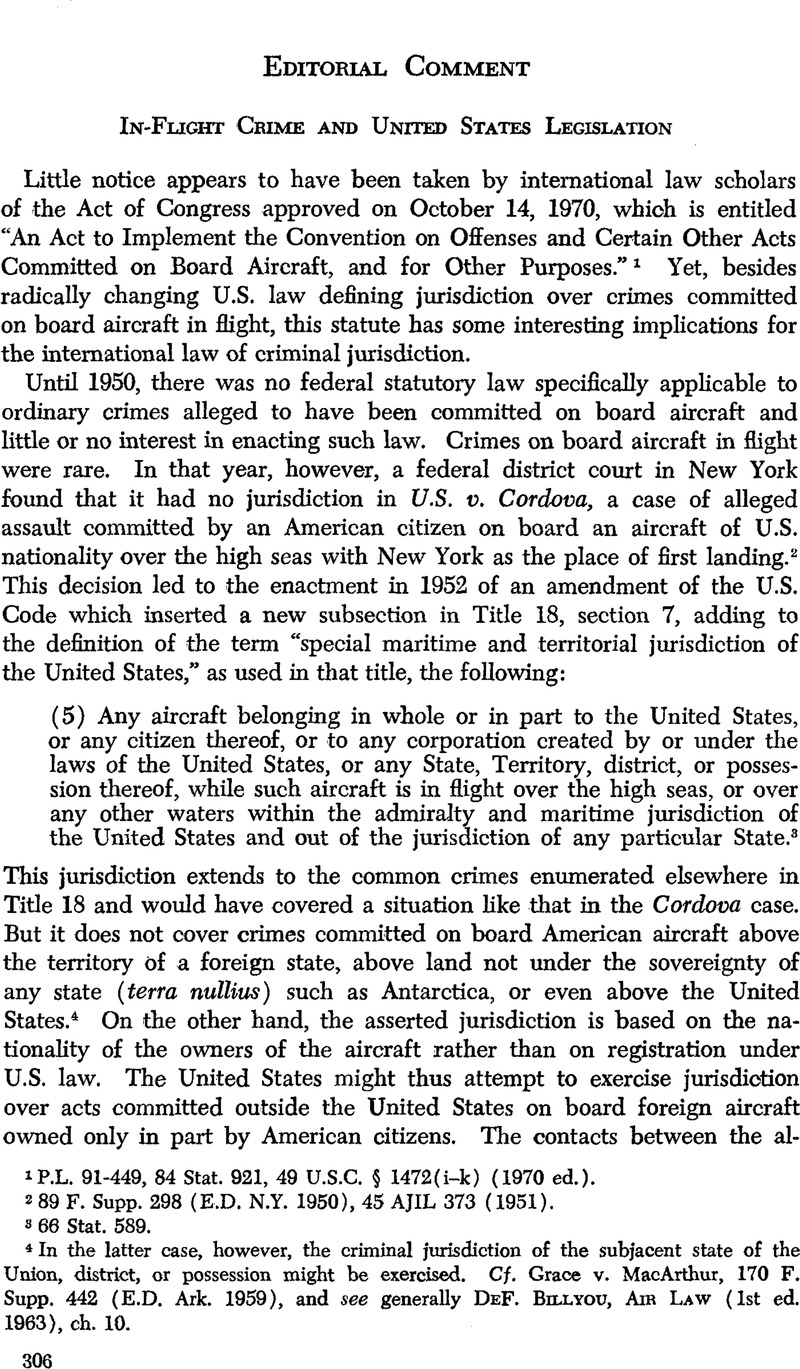Published online by Cambridge University Press: 28 March 2017

1 P. L. 91–449, 84 Stat. 921, 49 U.S.C. § 1472(i-k) (1970 ed.).
2 89 F. Supp. 298 (E.D. N.Y. 1950), 45 AJIL 373 (1951).
3 66 Stat. 589.
4 In the latter case, however, the criminal jurisdiction of the subjacent state of the Union, district, or possession might be exercised. Cf. Grace v. MacArthur, 170 F. Supp. 442 (E.D. Ark. 1959), and see generally DeF. Billyou, Am Law (1st ed. 1963), ch. 10.
5 75 Stat. 466, 49 U.S.C. § 1472 (1964 ed.). The crimes specified in the enumerated sections of Title 18 are assault, maiming, larceny, receiving stolen goods, murder, manslaughter, attempt to commit murder or manslaughter, rape, carnal knowledge, and robbery; they are identical with the crimes covered under Title 18, section 7, of the Code (see above). In addition, 49 U.S.C. § 1472 (k)(2) (1964 ed.), by reference to District of Columbia Code, § 22–1112, covers ‘lewd, indecent, or obscene acts,” as there defined. 49 U.S.C. 5 1472(j) (1964 ed.), furthermore, provides for punishment of interference with flight crew members or flight attendants, as defined.
6 49 U.S.C. § 1301(4) and (20) (1964 ed.).
7 For a full analysis and critique of this legislation and its ramifications, see Mendelsohn, , In-Flight Crime: The International and Domestic Picture Under the Tokyo Convention, 53 Virginia L. Rev. 509 (1967)CrossRefGoogle Scholar. See also H.R. Rep. 91–1535, 91st Cong., 2dSess. 2 (1970).
8 See H.R. Rep. 91–1535, loc. cit. supra note 7. Jurisdiction over U.S. military personnel is established by the Uniform Code of Military Justice. Non-military personnel on board U.S. military aircraft in flight over the high seas are subject to U.S. jurisdiction under the 1952 act, see text at supra note 3.
9 20 U.S.T. 2941; T.I.A.S. 6768. Text also in 58 AJIL 566 (1964). Art. 4 limits the freedom of parties other than the state of registration to “interfere with an aircraft in flight in order to exercise its criminal jurisdiction” to five specified situations. As of Feb. 23, 1973, sixty-three states were parties to the Convention.
10 Art. 1 of the Convention provides in part:
2. Except as provided in Chapter III, this Convention shall apply in respect of offences committed or acts done by a person on board any aircraft registered in a Contracting State, while that aircraft is in flight or on the surface of the high seas or of any other area outside the territory of any State.
3. For the purposes of this Convention, an aircraft is considered to be in flight from the moment when power is applied for the purpose of take-off until the moment when the landing run ends.
11 The right to assert criminal jurisdiction on the basis of the nationality of the aircraft on board which the crime is alleged to have been committed appears to have been already established in international law, as shown by the large number of states providing in their legislation for such jurisdiction and the opinions of many jurists. See, e.g., Harvard Research in International Law, Draft Convention on Jurisdiction With Respect to Crime, 29 AJIL, Supp., 439, 515–19 (1935); Fenston, & Saussure, De, Conflict in the Competence and Jurisdiction of Courts of Different States to Deal “With Crimes Committed on Board Aircraft, 1 McGill Law J. 66 (1952)Google Scholar. No state appears to have objected to this jurisdictional claim.
12 Art. 1(4).
13 See supra note 1. For background, see Mendelsohn, and H.R. Rep. 91–1535, loc. cit. supra note 7.
14 Non-military aircraft of the U.S. Government appear to be covered by virtue of the definition of “civil aircraft of the United States” in 49 U.S.C. § 1301(15) (1970 ed.) and provisions for registration of aircraft in the United States, 49 U.S.C. § 1401 (1970 ed.). The new act, however, fails to provide for jurisdiction over offenses committed on board aircraft “on the surface of the high seas or of any other area outside the territory of any state,” which are covered by Article 1(2) of the Tokyo Convention (see supra note 10). It is not clear that such offenses are covered by any other U.S. legislation. Cf. U.S. v. Cordova, supra note 2. It should be noted that neither the Tokyo Convention nor the 1970 statute covers crimes committed on board an American aircraft standing or taxiing on the ground on a foreign airfield, even though it may be there in transit for only a short time.
15 See Mendelsohn, supra note 7, at 548–58.
16 Cf. ibid., at 554.
17 1967 c. 52. See Samuels, , Crimes Committed on Board Aircraft: Tokyo Convention Act 1967, 42 Brit. Y. B. Int. Law 271 (1967)Google Scholar.
18 T.I.A.S. 7192; 65 AJIL 440 (1971); 10 ILM 133 (1971). As of Feb. 23, 1973, fifty-two states were parties to this convention. It entered into force for the United States on Oct. 14, 1971. For a discussion of this convention, see New Developments in the Law of International Aviation: The Control of Aerial Hijacking, Phoc. Amer. Soc. of Int. Law, 65 AJIL (No. 4) 71–96 (1971). See also Evans, , Aerial Hijacking: What is to be Done?. 66 AJIL 819, 821 (1972)Google Scholar.
19 10 ILM 1151 (1971); 66 AJIL 455 (1972). The United States deposited its ratification on Nov. 1, 1972. 67 Deft. State Bull. 615 (1972). Implementing legislation has been submitted to Congress.
20 For the proposed legislation, to be entitled “Anti-Hijacking Act of 1972,” and its history, see bills S. 2280 and H.R. 16191, 92d Cong.; S. Rep. NO. 92–1012, Senate Comm. on Commerce, 92d Cong., 2d Sess., Aug. 4, 1972; Cong. Rec. S15603–35 (daily ed. Sept. 21, 1972); id., H8963–70 (Oct. 2, 1972); Conference Report, 92d Cong., 2d Sess., H. Rep. No. 92–1599 (Oct. 13, 1972).
21 See supra note 14.